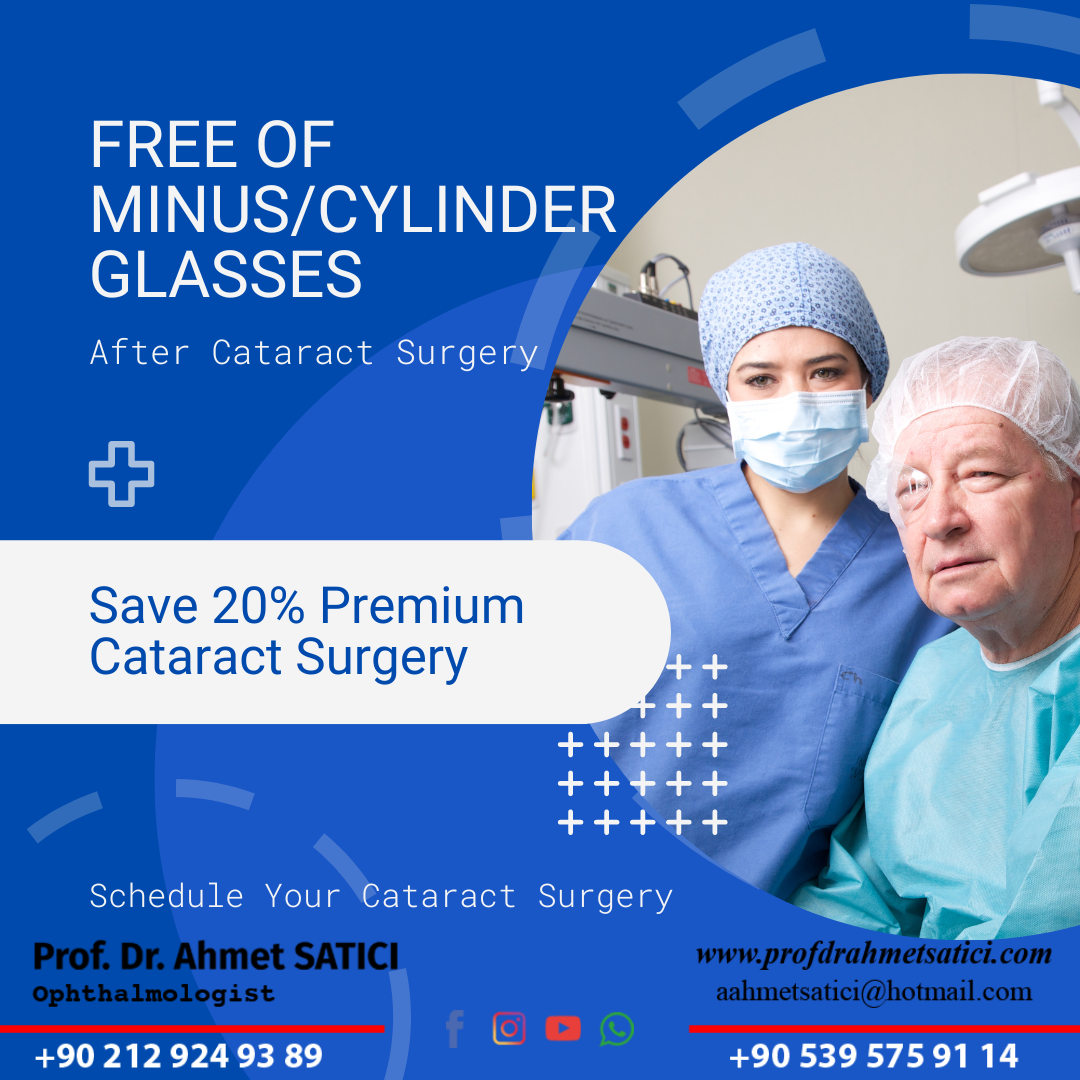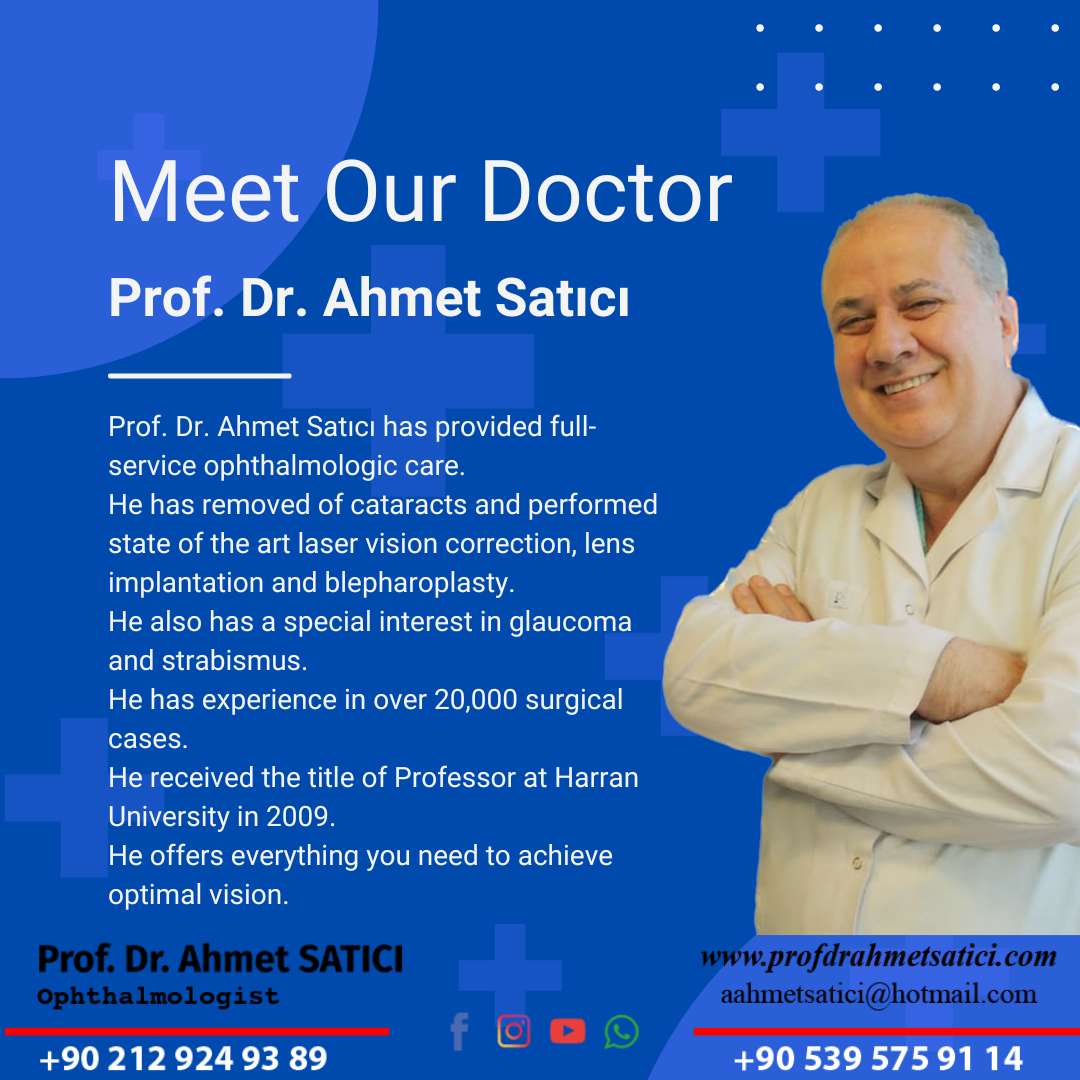What is Cataract?
Cataract is the blurring of the natural lens in the eye and loss of transparency in a way that prevents clear vision.
Cataract is a disease that matures over time. While there is a slight vision loss due to cataract at the beginning, this increases over time and the lens of the eye, which is normally a glassy and bright lens, loses its transparency, becomes more blurred over time and takes on a frosted glass appearance.
The only treatment option for cataracts is surgery.
Causes of Cataract
The main cause of cataracts is old age, but some babies are also born with cataracts. Other than aging, the main causes of cataracts include:
- Cortisone drug use
- Eye trauma
- Diabetes
Types of Cataract
• Age-Related Cataract:
Also known as senile cataract, it is the most common type of cataract. As the age progresses, the lens for the eye begins to lose its transparency. Cataracts begin to form in most people over the age of 40. It is estimated that about %50 of people will develop some form of cataracts by age 75.
• Secondary (Secondary) Cataract:
It is caused by diabetes or some eye-related problem. Steroid-containing drugs can also cause secondary cataracts.
• Traumatic Cataract:
Occurs due to eye trauma. These can occur immediately after the trauma or years later.
• Congenital Cataract:
Congenital cataract, also known as congenital cataract, is a congenital cataract in newborn babies.


Cataract Symptoms
The main symptom of cataract is decreased vision.
Other symptoms of cataracts include changes in eye numbers and decreased vision in bright light. For example, if your nearsighted glasses increase after the age of 50, this may be due to cataracts. If you can't see well at night and can't read signs in bright light, this could also be a sign of cataracts.
Cataracts do not cause sudden vision loss. If the decrease in vision occurs in a very short time, it is necessary to look for a cause other than cataracts.
Purpose of Cataract Surgery
In the past, in the treatment of cataract patients, the natural lens was removed and one of the monofocal lenses designed to see the distance clearly was used. In this case, it became obligatory for the patients to use glasses at close range after the treatment.
Today, the aim of cataract surgery has changed not only to restore vision, but also to get rid of glasses at all distances.
Trifocal intraocular lenses, popularly known as Smart Lenses, usually eliminate the vision problems of patients for life. Wearers of trifocal lenses do not have to wear glasses when looking at both far and near.
Patients who wear Trifocal (Trifocal) Smart Lens in cataract surgery can use a phone without glasses or do handwork at close range after cataract surgery; can use a computer without glasses at medium distance, cook a meal or see the speedometer while driving; They can watch television without glasses, drive a car, or see texts from afar without glasses. In other words, they can continue their daily lives without glasses.
For those who are fed up with their visual impairment, lens replacement surgery is the solution. This procedure is permanent and safe for people suffering from both hyperopia and myopia.
Lens Replacement Surgery Method and Procedure
Cataract surgery is typically performed with the phacoemulsification method (colloquially known as laser), needle-free and suture-free.
After the eye is anesthetized in the surgery, the cataract part is removed by creating an opening in front of the natural lens. Typically, instead of the natural lens, a new artificial intraocular lens is placed according to the eye's needs and numbers.
The operation is completed in twenty minutes.
You will be asked to rest for half an hour after the operation.
You will be asked to come for a check-up 1 day after the operation.
In general, a week is put between the operations of each eye. After surgery on one eye, the other eye can be operated a week later.
Our patients are generally comfortable because the surgeries are usually performed with numbing anesthetic drops.
Three to four days after the operation, the person can return to work.
If you work in a dusty environment, you should rest for at least two weeks.
Do not drive on the day of surgery to minimize recovery time and complications.
Avoid bathing for 4 days to minimize the risk of infection.
We ask you not to enter the pool and the sea for 2 weeks.
Avoid activities such as lifting heavy objects and bending over for several weeks.
Do not put unnecessary pressure on the eyes. Do not rub your eyes after surgery. You may feel itchy eyes for a while, but this is normal.
Do not expose your eyes to dust as this can increase the risk of complications.
Take the eye drops prescribed by your doctor.
Shortly after the surgery, most of our patients report that their vision has improved. However, recovery continues the week after surgery and vision continues to improve.
The surgically placed artificial intraocular lens replaces the natural lens and is not on the surface.
So you can't feel this lens like a contact lens. It is designed to last a lifetime.
